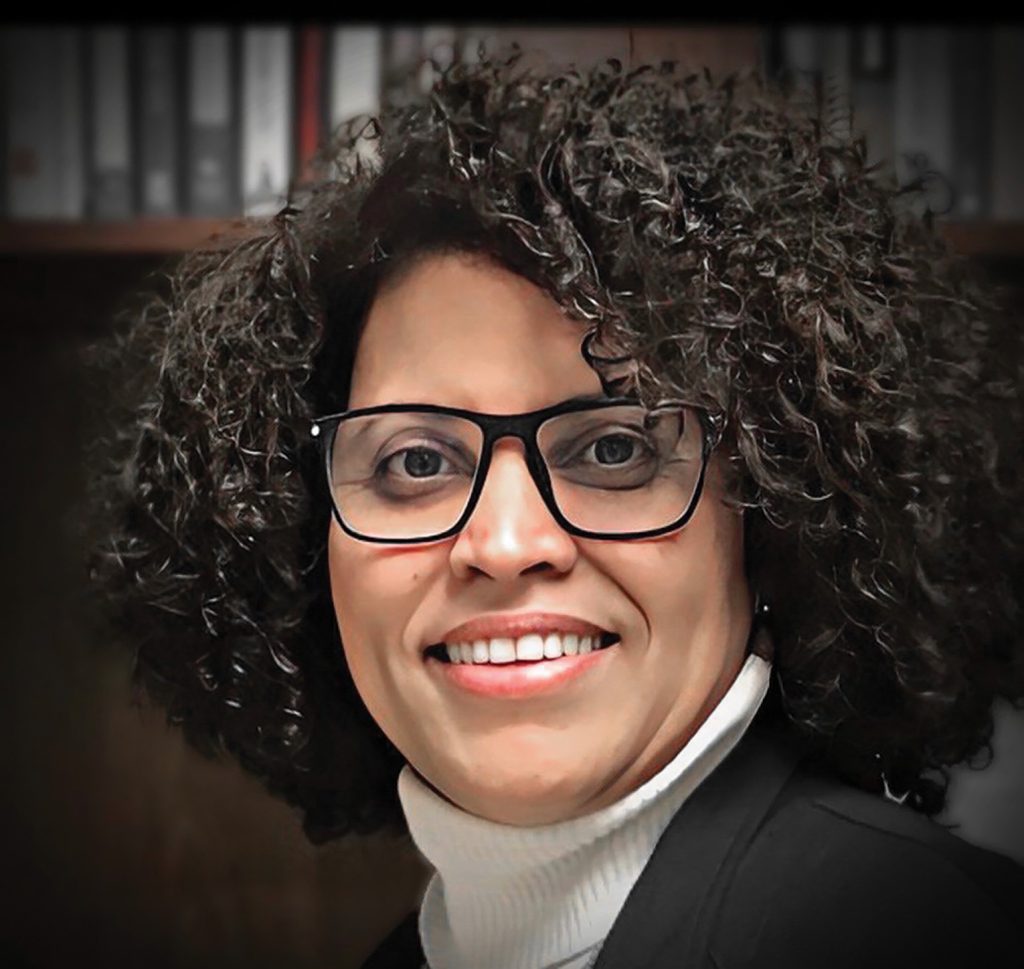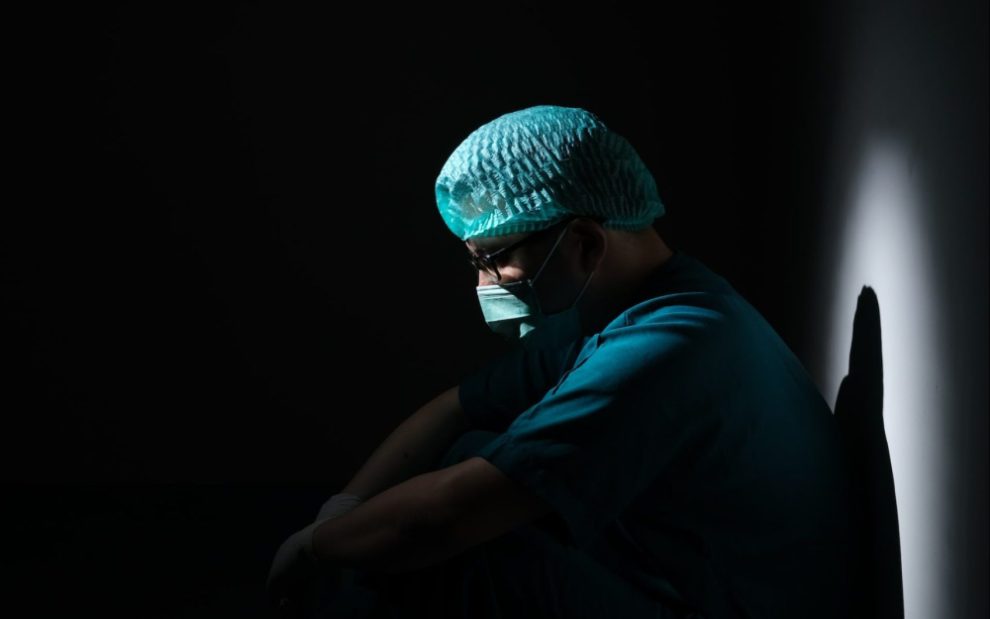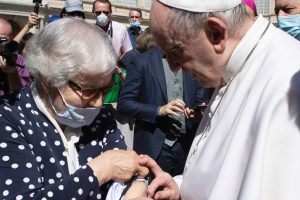As of September 2022, more than 1 million people have died of COVID-19 in the United States. This is more than twice the number of U.S. citizens who were casualties of World War II, which is estimated to have taken the lives of approximately 420,000 Americans. But those deaths, and those in ensuing military conflicts, happened mostly on foreign soil. This may be one reason why our culture is reluctant to name and confront death, even though our news cycle is filled with reports of gun violence, wars, genocide, and famine. For the comfortably well-off in this country, death is something that happens elsewhere to other people.

The COVID-19 pandemic changed that for many of us. It forced us out of our comfortable denial. Whether witnessing news reports of daily death tolls or suffering grievous loss in our own lives, death became a part of our collective experience in a new and disorienting way.
Dominican Sister Xiomara Méndez-Hernández was working as a chaplain at Loyola University Medical Center in Chicago when the first COVID-19 patient died there. In the following months, as the death count rose, she continued to work, accompanying the dying and their loved ones. For Méndez-Hernández, the pandemic has been a time of reckoning with death’s reality. Amid the fear, grief, anger, and uncertainty, recognizing our own vulnerability, she says, has opened us up to the possibility of peace and to a better understanding of what a “good death” means.
Why were you drawn to hospital chaplaincy?
I grew up with medicine in my house. My sister is a doctor, so growing up I learned a lot about medicine. I was her assistant sometimes when she was working in a big inner-city hospital. Volunteering there, I learned how to do IVs, shots, stitches, you name it.
For a while I volunteered at a clinic, Casa de Salud, which serves uninsured or underinsured people in St. Louis. Many of the patients were immigrants or people of color. I accompanied people and listened to them while they were waiting for the doctor. Many of them didn’t speak English. I interpreted for the ones who were Spanish-speaking and listened to their stories while I was translating for the doctors.
This is how my passion for health care started. So when I decided to become a sister, and I was looking for a ministry, somebody told me there was a career called chaplaincy. And I said, “What is that? Tell me more.” When I started asking, they said, “You will be perfect for this.”
What kind of training is required to become a certified chaplain?
There are different kinds of chaplains, such as military chaplains and chaplains for the homeless. To be a clinical or hospital chaplain in the past, you only needed to have internships or a residency in a hospital setting. But now you need to have at least four units of clinical pastoral training, whatever your denomination. Then you need to have at least a master’s degree in theology, divinity, or pastoral studies.
What are the typical duties of a hospital chaplain?
If someone is a full-time chaplain, they cover the whole hospital. Some hospitals have different shifts—it depends on the level of acuity of the hospital. For a level 1 trauma center, which provides total care for every aspect of injury, a team of chaplains needs to have 24-hour availability.
Are there also chaplains who are not religiously affiliated?
This is a trend that is growing now, because of the increase in religiously unaffiliated people. That doesn’t necessarily mean these people don’t have faith. Not having a religious affiliation is not always the same as being atheist or agnostic. There are different levels of belief. Some people are not affiliated with any church but do have a faith.
I know one chaplain who has no religious affiliation, but he has compassion and the ability to listen. The call of chaplaincy is to become a compassionate presence. Those who are religious try to be a compassionate presence of God. Our main role is to listen and counsel spiritually, emotionally, or both.
What was it like to offer this ministry at the start of the COVID-19 pandemic?
This virus was so new. We knew nothing or very little about it. This wasn’t a simple flu, even though it had some elements of the flu or of a cold. But it was taking lives so fast that we, and the doctors and nurses, felt hopeless and helpless. We tried so many treatments, yet we lost so many people so fast. It was so different. No one in our generation had seen anything so devastating and so contagious. This deadly virus was something that nobody was ready to face.
Is it correct that you were the chaplain on call when the first COVID-19 patient died in Chicago?
I don’t know if it was the first COVID-19 death in the whole Chicago area. But it was the first at Loyola University Medical Center, which is one of the biggest hospitals in Chicago. I had just come in at 7 a.m. The overnight chaplain said, “We have a patient dying.” Then, just as we were receiving the patient’s report, we got a call that the patient had expired.
The doctor asked me, “What do I do?” At that time, no family was allowed to come to the hospital, only the staff and the patients. We didn’t know if the family was carrying the virus, or if coming into the hospital might expose them to the virus. And this patient was a mom who just two or three days before was talking to her family. Then she was sick and came to the hospital. Less than three days later, she was gone. That family didn’t get to say goodbye.
After the doctor told this woman’s family that she had died, we had to call them. This is part of the protocol: After the doctors and nurses communicate with the family, we take over. We accompany the family in the grieving process. We discuss what to do after their loved one has died, how they want to honor the body, what religious affiliation they may have. If they don’t have a funeral home picked out, we navigate that with them, because for many people it’s all new.
And this was a sudden death. The patient was in her 60s. The family was not ready. They had no funeral arrangements, nothing. And we didn’t know what arrangements the funeral homes had, as this was a very contagious virus.
The patient’s two daughters cried on the phone because they never got to say goodbye to their mother. That was one of my hardest moments as a chaplain: hearing a daughter say she was not able to be with her mother, to hold her hand and say goodbye.
Now, 2½ years later, there’s been a lot of conversation about the exhaustion that our essential and health care workers have experienced. Is that affecting your work?
That was the first death. Since then, we have had hundreds and hundreds. In less than three months, we had more than 500 deaths. At that point, we sat down as a team to debrief. Every single day we were called. Every single day we accompanied families by phone. We were beyond exhausted. I don’t think I have been that tired in my whole life.
Yet I think of the passion and compassion of the whole team, even the people who cleaned the rooms. We were all exposed to COVID-19. Yet we were there not only for the patients but for one another. That resiliency and collaboration helped us prevent burnout and keep going. When I saw a doctor crying, sometimes I would comfort them, sometimes just pass a tissue or bottle of water. You had to be so careful because you couldn’t touch anybody.
Earlier you mentioned your work with immigrant populations. What challenges did you experience caring for them?
Who are the people who work in service, the people who cannot afford to stay home? Who are the people who can’t do remote work? Immigrants and Black people and people of color. They have to go to work. They are the essential workers. Some work in the hospitals, others clean houses or prepare food in restaurants or work in grocery stores. And these were the people who died. The ones who were serving us, who didn’t have the privilege of working from home, who couldn’t stop working because they had no savings.
Some of them had no family nearby, so we had to contact family members in different countries around the globe. That may have been the hardest part. Some had left their children behind when they came here. Who would take care of them now? In one family, both the mother and the father died, and their siblings were the ones who took care of the children. It was one story after another.
Can you talk about how technology affected your ministry during the pandemic?
We needed to be creative. We did video calls so people could see their loved ones. Remember, these patients were in isolation. One patient—a cancer patient, not a COVID-19 patient—said to me: “It’s not the illness that is killing me. It’s the loneliness.”
We used tablets and equipped the families with the apps they needed to video call. We had to buy all the equipment. But you cannot imagine the change after that. Patients were finally able to see their families. They’d have group video calls. We’d have people picnicking, celebrating Father’s Day and Mother’s Day.
Technology was a real blessing to us. I think that was the light at the end—well, in the middle—of the tunnel.
What’s it like in a room when a person dies?
Perhaps before we discuss what happens when a patient dies, let’s talk about what happens before a patient dies. If it’s not a sudden death, there’s anticipatory grief. If it’s a sudden death, it’s a different scenario.
But when the person dies, it is such a sacred moment. Sometimes they are just talking, and they close their eyes and slip away. Sometimes they have been suffering for so long that death, for them, is like finally resting. But the family is not always ready to say goodbye. Of course, it depends on the patient.
If the person is homeless, when they die we become their family. One of the principles that many hospitals have adopted is that no one dies alone. If the family is not there, one of us will be there, or maybe a nurse, tech, or doctor. It is a sacred moment.
Every case is different. If the patient is Catholic, we pray while they are dying. And sometimes we are all silent. A lot depends on the person and their social or religious identity or if they have a loved one with them.
The cultural part is significant. If the patient is Latino/a or African American and they have family nearby, we know there will probably be a lot of people who will want to be with them. For those of white European descent, it’s a different dynamic. And even within that dynamic, there are variations. For example, if the patient is Italian, they may have a big family. In some families, everyone is very quiet, very proper. And some prefer not to be there when their loved one dies. So again, there are different scenarios, depending on the cultural background or circumstances.
How do chaplains help people have a “good death”?
One class I took while training was on God and the mystery of human suffering. It taught me how to have conversations with both patients and families on a deeper level. Often people suffer not only physically but emotionally.
Religion can be either a help or a hindrance for a good death. Many people have unresolved issues, such as guilt or regret. That can affect not only a person’s health but also the way they depart from this world. If we can have a deep conversation, or even several such conversations, we try to help the person process their diagnosis and review their life.
When a person is diagnosed with stage 4 cancer, which means the cancer has metastasized, it is devastating. The person may be told they only have a few months to live. Often I hear them say, “I want a little more time.” And if I can, I ask, “For what do you want a little more time?” So they start reviewing their life. One patient asked me, “Did I really live my life?”
We help people process and make peace with their past, whatever they are facing.
A beautiful death, as I see it, is when you are at peace with your present and with your past and when you are not afraid to die. Because almost everybody faces the fear of death. Only rarely do I see a person who is ready to die. Recently I had a lung cancer patient who told me, “I’m not afraid. This is not the end. It will be continued. I don’t know how, but it will be continued.” Her family was devastated, but she was so ready. It blew my mind. I want to be like her when it’s my time.
How do you think our culture and communities could do better when it comes to encountering death and dying?
I had a community-oriented upbringing. We have close families, close communities. Even if you don’t have family, you have the community. And for us, death is part of life.
But people in this country have a great fear of death. Sometimes it is hard, even for doctors, to say the word death. People don’t want to talk about it. They avoid you when you start talking about it. They refuse to have honest conversations or resist having a power of attorney—something we try to help people do so it does not become a problem at the end of life.
In this society, people are so independent, so much in charge of their lives, they are like, “It is my right to be alive.” So it’s difficult when death happens.
If a person gets a diagnosis when they are young, this is a struggle. It is hard. I can’t imagine being very young and being told I don’t have much time left. But where is the support system that will help you navigate the process? With more and more people who don’t have the spiritual support that some of us have, the struggle is even harder.
This is true for both religious and nonreligious people. Here I think the struggle is harder. This is my experience coming from a different perspective and culture. Many people live in denial, but the truth is: If you are alive, you will die.
After more than two years of the pandemic, have you seen a change? Are more people beginning to realize that we need to be honest about death?
The grace of COVID-19 is that people have faced that we are vulnerable. People come in having already made plans, even for their funerals. It has been a great shift.
How does someone’s political or ideological stance affect how they experience COVID-19 and how they face death?
I’m in Florida. This is one of the states where many people refuse to admit the pandemic is real. It saddens me that people still don’t believe that COVID-19 can harm you or even take your life. People have taken a political point of view, or even a religious point of view, that is against the science and against the reality we see every day. Unfortunately, even our own religions and churches have sent the wrong message. I have seen many people who contracted the virus because they went to church without masks. It has been a great disappointment for me, not only the societal failure but the failure of our churches too.
As someone who has encountered death on a regular basis, do you have any advice on how to think about death?
Try to make peace with yourself first. Then make your peace with God, if you believe in God, or with whatever you believe in. If you believe in goodness, try to make peace with goodness or practice goodness. Make peace with your past and your present, and don’t put all your eggs in the future. That basket is not secure.
I think the important thing is to live life in the present and be the best human being you can be. Try to live in peace, to make peace, to build peace, and to live authentically. Try to do things that give life. That is all you can take with you.
I share this blessing with my patients most of the time. It’s a blessing that we Dominicans as an order share with one another. It’s very short and sweet. Most of my patients, even the ones who don’t believe, like it: I say to you, may God Creator bless you. May God, who is Redeemer, heal you. And may God, the Holy Spirit, fill you with light and peace. Amen.
This article also appears in the November 2022 issue of U.S. Catholic (Vol. 87, No. 11, pages 20-23). Click here to subscribe to the magazine.
Image: Unsplash/Mulyadi














Add comment